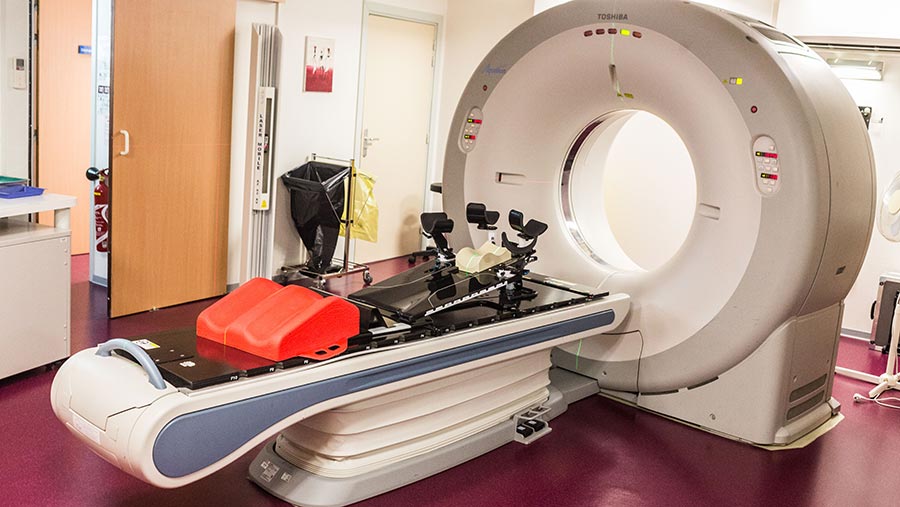CT scanning set to influence terminal and maternal traits
 © BURGER/PHANIE/REX/Shutterstock
© BURGER/PHANIE/REX/Shutterstock Computerised tomography (CT) scanning has demonstrated its value in sheep carcass improvements and could be used to play a role in lambing ease prediction.
A range of measurements such as hip width, shoulder width and pelvic angle and dimension can all be measured and factored into lambing ease calculations, said SRUC sheep geneticist Nicola Lambe.
See also: Guide to CT scanning and how it can benefit your flock
Furthermore, trials have started looking at rumen characteristics such as reticulorumen volume to suggest that CT scanning can be used to inform studies into methane emission and rumen efficiency.
Exactly when and how these features will be incorporated into breeding values is unknown, but the technology shows great promise with muscle fat and bone prediction at 98%, 99% and 89% reliability respectively.
Dr Lambe stressed that the accuracy of CT scanning is far superior to ultrasound, which has an accuracy of just 60%.
“Rams sold with CT scanning information can be worth more and the traits are moderately heritable,” Dr Lambe told the iTexel conference at Penrith on 17 November. “We are also beginning to look at some novel applications for CT scanning, such as lambing ease predictors.”
Alwyn Phillips, Penygelli flock, Caernarfon
CT scanning has been at the core of Alwyn Phillips’ balanced breeding programme for more than 20 years and has paid dividends, propelling the Penygelli flock into the top 1% of the breed’s terminal index.
The flock’s average terminal index stands at 439, above a breed average of 278.
However, ewe functionality has also been monitored, which has seen maternal ability lift to 1.2, putting it well within the top 10% of the Texel breed and ahead of the current breed average of 0.57.
Mr Phillips – who runs 200 Texels and 200 poll Dorsets in a cell-grazed, grassland-based system – selects stock rams each year through a three-step process.
- Use Signet inbreeding spreadsheet to select four tupping groups based on lambing ease, back fat scanning and birth, eight-week and 20-week weights.
- Select top five ram lambs from each of the four groups for CT.
- Using CT data, select two ram lambs as stock rams on a balance of the carcass traits.
Ram lambs are scanned each summer at an average weight of about 40kg.
Initially, Mr Phillips took sheep up to Edinburgh for scanning, but since 2009 has been able to call on the services of the mobile CT scanning team, which scans the sheep at Aberystwyth.
Costs for CT scanning are currently averaging about £45 for every lamb tested after HCC (Hybu Cig Cymru) and Texel Society subsidies.
|
Averages from 2018 CT scanning results |
|||||
|
|
Total carcass weight (kg) |
Kill out % |
Fat (kg) |
Muscle (kg) |
Bone (kg) |
|
Average for 2018 |
18.375 |
45 |
2.312 (12%) |
12.869 (70%) |
3.194 (17%) |
|
Average for 2017 |
21.03 |
46.1 |
3.05 (14%) |
14.45 (69%) |
3.5 (17%) |
Commercial focus
While terminal traits are important, Mr Phillips stresses that his policy has been to replicate a commercial system, growing lambs off grass alone and minimising concentrate.
Functionality of flock genetics has been maintained through careful observation and recording of lambing ease, which has seen maternal ability lift from 0.49 in 2000 to 1.2.
Mr Phillips is recording footrot and mastitis and is lambing from 25 March, to ensure grass availability.
